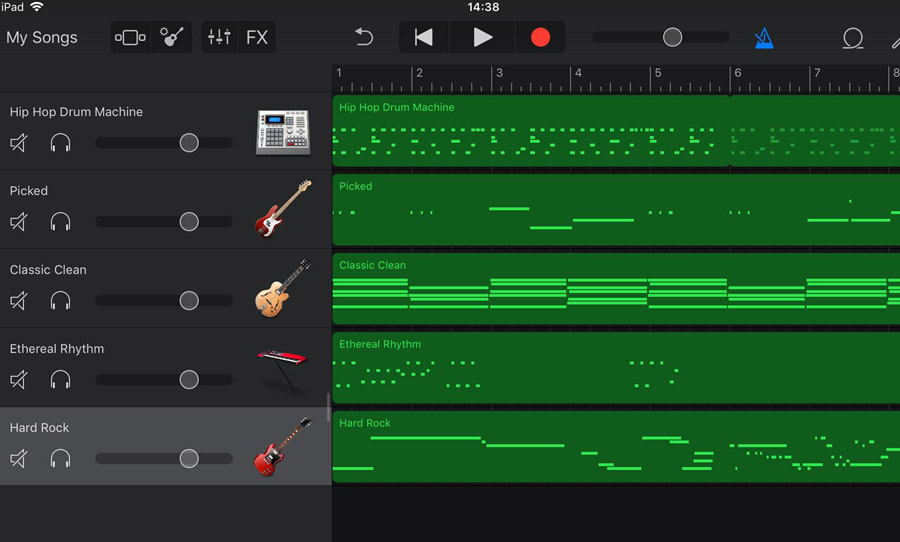For a long time, GarageBand has been the first digital audio workstation experience for many kids. It just makes so much sense: a school buys a bunch of Macs and already, right there in the box, you’ve got the means to make music.
To ease the learning curve, the music itself is available to slot together in a prepackaged format. Key, rhythms, tempos appear as self-contained loops, ready to be joined up like a bookshelf from IKEA. Coupled with a clean and inviting graphic user interface, the software is designed to encourage beginners to come and play.
Of course, this low bar to entry can result in dismissal or even ridicule from experienced DAW users. Yet, GarageBand has also crossed over into the professional realm, favoured by producers who appreciate its no-fuss workflow, that also invites spontaneity and experimentation.
GarageBand has often been dismissed as a toy and definitely not for the pros. But a growing number of creators are making this free DAW the hub of their productions.
Sweet sixteen
For a DAW that has had such widespread adoption, it’s been around for a surprisingly short time. Turning 16 this year, GarageBand is younger than many of the major DAWs, including Pro Tools, Ableton Live, Cubase and significantly, Logic Pro.
It’s a common misconception that Logic was born out of GarageBand, extending the functionality of this user-friendly software into the professional realm. In fact, Logic first appeared in the ’90s as a software for Atari ST, then Mac and Windows. Apple bought Logic’s parent company, Emagic, in 2002 and subsequently brought it into the Mac ecosystem. It was a bold but prescient move – hiring the talent at Emagic meant they could lay the groundwork for a music creation tool that would cater to all.
GarageBand, together with iMovie, would reshape Apple’s reputation as a platform for creatives. The fact that it came free and pre-installed on every Mac underscored this point: if you wanted to join in the fun, all you had to do was buy the computer.
When the software first appeared, there were limitations that reminded the user that there’s no such thing as a free lunch. Its resolution peaked at 16-bit/44.1K (the standard of CD resolution, but still below what other DAWs were capable of), plus you could only record one track at a time – not really ready for a studio session. Engineers who made their living in the studio, however, wasn’t the target audience.
What it lacked in recording specs, it made up for in versatility. Drag and drop functionality is central to the GarageBand experience. Virtual synths, guitars, basses and drum kits are all there when you need them. It all reminds you that the ‘Band’ in GarageBand is integral to its appeal: if you need to bring an idea to fruition, fast and for free, this is the environment for you.
Loops of a set length could be dropped into sessions, magically conforming to global tempos. Tools like this enabled absolute beginners to shift musical events in time; in a deep and intuitive way, GarageBand became a way for novice musicians to understand arrangements.
Expansion
It didn’t take long for the software to expand on its functionality. In version 2, multitrack recording capability was added, number 3 included the podcast studio and in number 4, exporting to iPhone ringtone was enabled. In appealing to such a broad range of users, Apple was incentivised to keep innovating.
Nowadays, GarageBand can power sessions of up to 255 tracks, is FlexTime enabled, has scope for building virtual guitar rigs and more. There are too many features to mention that place GarageBand well and truly in the pro category, which might explain why a plethora of hits have been made with it.
The prodigious Steve Lacy, who’s produced tracks for Kendrick Lamar and J.Cole, releases his own music and plays in The Internet uses GarageBand as the hub for his productions. Extraordinarily, it’s the GarageBand iPhone app that he prefers rather than the desktop version. Canadian artist Grimes produced her breakthrough album Visions using GarageBand, while Rihanna‘s megahit Umbrella famously used a GarageBand drum loop as its irrepressible backbeat.
So while GarageBand has lured several high-level artists with its charms, does it purport to be a professional platform? The answer is a definitive no. While the two DAWs share much of the same DNA, Logic Pro is very much marketed as Apple’s professional DAW and comes at a cost.
GarageBand, while evolving to incorporate many professional features, still presents a simple, clean and user-friendly avenue for beginners to begin their music production journey. But it’s very user-friendliness and speed of workflow that have attracted many professionals, almost by accident.
It will never be able to match the specifications of some of the established professional level DAWs, nor does it want to. But as a way to execute ideas at speed and experiment with sound and structure, GarageBand has proven itself time and time again.


